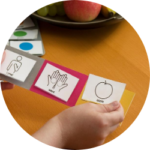Remote Learning: Tips for Parents and Professionals
August 27, 2020

Note: This article was originally published in 2020 when many school districts and families were making the decision to return to school with an all-remote or hybrid option. Families and teachers were being asked to assume a lot more responsibility in their child’s schooling.
This guide of practical strategies and resources can support learning when your home is now the classroom.
 Parent-Teacher Communication
Parent-Teacher Communication
It will be extremely helpful for parents and teachers to connect at the beginning of the year. This will help to avoid a lot of “trial and error” and help you know what you can expect.
What will the school’s remote learning system and workload look like? Ask the teacher what online processes you need to know, and what the weekly activities will be. Ask for specific links and passwords.
What skills will be targeted from home? Discuss ways to include home activities as educational opportunities (e.g., putting away laundry, preparing a simple meal).
What individualized strategies will be implemented at home? Ask for practical advice on the best ways to direct, guide, and support learning and development from home. You may wish to ask for ways to teach choice making, communication, waiting, and other everyday skills.
What can be done about regression? Many parents and teachers are concerned that regression of skills will impact the upcoming school year. To learn more about what regression looks like and ways to prioritize lost skills, please read Regression during a Pandemic.
Schedule a weekly touch base to ensure you’re communicating on a regular basis. Use a parent-teacher contact log or communication app to discuss that week’s successes and challenges.
 Supportive Environment for Remote Learning
Supportive Environment for Remote Learning
Here are some tips for simple modifications to your home to create an environment conducive to learning.
- Calm environment: Create a calm, organized remote learning environment to help meet the needs of learner.
- For example, have a plan for pets or other family members during remote instruction, try soothing music in the background, create space for both seated work and a movement break.
- Organize in advance: Prepare and organize instructional materials in advance.
- Try using color-coded folders or labels for different subjects or activities (e.g., all reading work goes in a blue bin, math in the red bin, and leisure work in the green bin).
- Plan what’s visible:
- Motivate: Have a few motivating items visible that you want to include during remote learning. This may increase the learner’s motivation to participate.
- Hide: If certain items and activities are not allowed during remote learning, be sure they are out of reach and out of view.
- Safety Concerns:
- Rules: Set expectations for a safe learning environment and what the rules are (e.g., safe hands, wait your turn, sit nicely). It may help to post these rules in the room with words or pictures.
- Be mindful of safety concerns (e.g., locking cabinets, removing heavy items that could be thrown in the heat of the moment, having soft cushions and pillows accessible in case they might be needed).
- Visual Supports: Visual supports should be posted in the home learning environment to promote independence.
- These can be pictures or words used for work instructions, behavioral reminders, free time options, steps to check off, labels, and choice making. Boardmaker (free 60 day trial subscription) has resources for creating both personal and professional visual supports.
 Communication Tips to Promote Attention
Communication Tips to Promote Attention
It’s critical to help individuals with autism communicate wants, needs, and feelings, especially given the additional challenges of remote learning. Some individuals communicate vocally, and others communicate with picture symbols, sign language, visual boards, or a technological device. Consider what verbal, nonverbal, and visual strategies may be needed to facilitate communication and interaction in a remote setting.
| Here are some suggestions. | For example |
|---|---|
| Use simple, clear language | “Look at me” or “Open the book.” Keep directions brief. |
| If-then and first-then statements | “If we read two pages, then you earn a token.” or “First math, then dance break.” Be consistent with these statements. |
| Positive language | “Listen, please.” instead of “Stop talking." |
| Frequent and specific praise | “You shared the toy!” rather than “Good job.” |
Motivation in a Remote Setting
An individualized reinforcement plan should be included to encourage appropriate behavior and/or task completion during remote learning.
Reinforcers may involve being able to participate in a preferred activity or sensory experience, attention from a particular person, a special treat, a break from work, or a token system to earn something of their choice. If you are unsure what is motivating to your child, speak to the teacher, behavior analyst, and/or or look up different reinforcer assessment inventories.
Know the least amount of reinforcement needed to keep your child actively participating (e.g., chips or a token after completion of one step or earning something special at the very end).
Make sure the reinforcer’s value matches the effort. This is highly individualized and may need to be re-evaluated even within the same day depending on how they are feeling. For example, if the learner is tired, hungry, or bored, the effort could be greater than when they are feeling well.
Our article, ABA In Action, offers more specific information on the general hallmarks of ABA including positive reinforcement to facilitate learning and participation.
Strategies to Support the Learner
Teaching Methods
Social Stories can be customized for the child with a focus on the skills or behaviors of concern (e.g., talking to strangers, kitchen safety, using manners). You can read the story several times in a remote setting and have questions prepared to share and discuss together.
Modeling is showing someone what to do and then waiting for them to imitate the desired behavior (e.g., checking off steps in a schedule).
Video modeling is showing videos explicitly illustrating the steps of a specific task or skill. Many individuals with autism benefit from seeing the targeted behaviors in action, and remote learning is a great time to utilize this strategy.
Direct teaching is the most straightforward and traditional way of teaching new skills to students. The teacher will present the skill remotely, and the caregiver can help walk the child through what to do with modeling, prompting and reinforcement.
Additional Supports

Set clear expectations so the lessons and activities run more smoothly. Learners with autism do well with activities that have a beginning, middle, and an end.
Provide them with choices while they are completing their work such as what color pen they use, choosing a seating arrangement, etc. These small choices may help them enjoy completing the assigned tasks.
Have “break” and “wait” cards available. For example, if a student completes their work, they can earn a 5-minute break. This break can prevent inappropriate behavior. Have a visual card with a small picture of someone waiting nicely and taking a break, or with the words “wait” and “break” on them.
You may need to provide different tasks and/or alternative work if what you are working on is not going well and to keep the momentum going.
Additional Considerations
Behavior Support
If challenging behaviors are interfering with remote learning and attending, consider using a function-based approach to identify “why” the behaviors are occurring.
We suggest reading our FAQs on Functional Behavior Assessment and general strategies for Managing Severe Challenging Behavior in the Home
 Online Safety
Online Safety
If you’re concerned remote learning means more access to the internet, KidSmartz and NetSmartz offer safety materials, lessons, videos, and games designed to teach children ages five to seventeen about online safety.
Experience Our Power of Connection
For additional information and resources, contact Autism New Jersey at 800.4.AUTISM or email information@autismnj.org.
Learn More: Autism New Jersey Annual Conference offer dozens of educational workshops for parents and professionals. Check it out!
Originally posted: 8/27/2020
Updated: 1/18/2023

 Supportive Environment for Remote Learning
Supportive Environment for Remote Learning Communication Tips to Promote Attention
Communication Tips to Promote Attention
 Online Safety
Online Safety